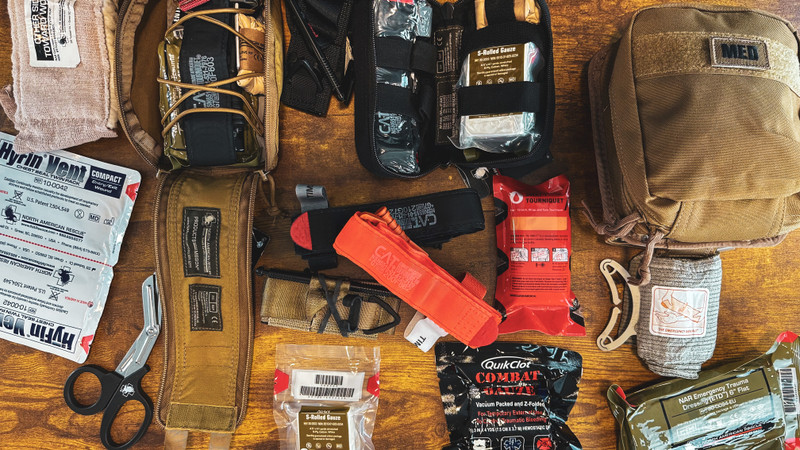Building Your First IFAK: 5 Things to Include
Individual First Aid Kits come in many shapes and sizes and contents often vary. An IFAK can be curated to the activity you are participating in, however we are going to stick with 5 essentials you should have. We want to steer clear of the prepacked survival kits that are littered all over Amazon. These are often built of inferior medical supplies that can do more harm than good. After all, what good is it to buy a fake C-A-T Tourniquet and have the windlass snap during an arterial bleed?
IFAK's catch a lot of flack. While they can be deemed for the "prepper", a one-time investment can save your life, the life of a family member, a friend or stranger. IFAKs are used by law enforcement, military, and first responders, but when help isn't nearby and there is massive hemorrhaging, you need to be prepared.
For this article, we are going to run through the 5 basic necessities of an IFAK.
TOURNIQUET
A proven way to stop bleeding, the tourniquet is the center of your kit. Most user's go-to is the North American Rescue C-A-T Tourniquet. This tourniquet has been on a pedestal for years and does not seem to be going away anytime soon. Thanks to its reliability and proven track history, it is also the most counterfeited tourniquet. Yes, there are fake tourniquets. Most individuals new to the tactical medicine world or casual shoppers will not realize and most may not care however these pose severe reliability issues.
When purchasing your first tourniquet, we recommend getting two. One for training and the other for its intended use. You do not want to be in a situation where you need to use a tourniquet and apply it improperly due to lack of training.
Tourniquets to check out:
- North American Rescue C-A-T Tourniquet Gen 7
- TacMed Solutions SOF Tourniquet Gen 5
- Safeguard Medical SWAT-T Tourniquet
- Safeguard Medical TMT Tourniquet
- For your K9 friends, check out the TacMed Solutions K9 Tourniquet.
PRESSURE BANDAGE
Wounds in locations that cannot be remedied with a tourniquet or wounds that do not have extreme hemorrhage can be remedied with a pressure bandage. In layman's terms, a pressure bandage is a long elastic band with a non-adherent pad attached. Most are self-explanatory on how to apply, but we find the easiest to be the NAR Emergency Trauma Dressing (ETD). If you are looking for a "do-all" pressure bandage, you can look no further than the PerSys Israeli Bandage. This bandage works similar to the NAR ETD, however it has a pressure bar to allow more pressure on the wound. More pressure = less bleeding.
GAUZE
There is always a debate between standard gauze and hemostatic gauze. We like to stay out of that argument. If you are not familiar with hemostatic gauze, essentially it is standard gauze impregnated with a reactive solution to stop bleeding faster. We recommend purchasing what fits your budget and even further suggest you know how to pack a wound.
Our Picks:
CHEST SEAL
One of the scariest injuries is a gunshot wound to the chest. Furthermore, there is a good chance the bullet passed through the body and you now have an exit wound. A chest seal helps to ensure there will not be a collapsed lung and a vented chest seal allows air to escape through the chest but not enter through the chest. The NAR HyFin Compact Chest Seal comes with two seals (entry and exit) and is vented to allow assistance with airflow.
Our Pick:
SHEARS
Shears may seem like a simple option, but being able to cut clothing away and identify wounds will make your life much easier, especially if there is a chest wound and the victim is lying on the ground. Simply cut away the clothing and apply your chest seal. Please do not add kitchen scissors or office scissors inside of your kit. Cost-effective options like responder shears do not cost much and are of phenomenal quality.
CONCLUSION
You can go as far as you want with an IFAK, but knowing your supplies and training with your supplies is essential. We cannot stress training enough and highly recommend enrolling in a local first aid class. Other key items to add are a mylar/space blanket and gloves. The body can start to enter hypothermia if its temperature drops 2 degrees below its standard temperature. Gloves allow you to safely work on your victim while reducing the chance of disease. We also recommend sticking to gloves that are latex-free and any color but black. In low light environments, it may be harder to see blood on your gloves, hence taking more time to find the source of bleeding.
And remember it is an IFAK, so keep it in arm's reach.
-
Gift shopping for guys can feel tricky, especially if he already has everything or he’s the …Nov 23rd 2025
-
Essential Medical Tools Every Hiker Should Carry When Backpacking in 2025 Backpacking into remote or …Aug 1st 2025
-
When uncontrollable bleeding occurs you want to be prepared. Having an effective tourniquet on hand …Jun 25th 2025




